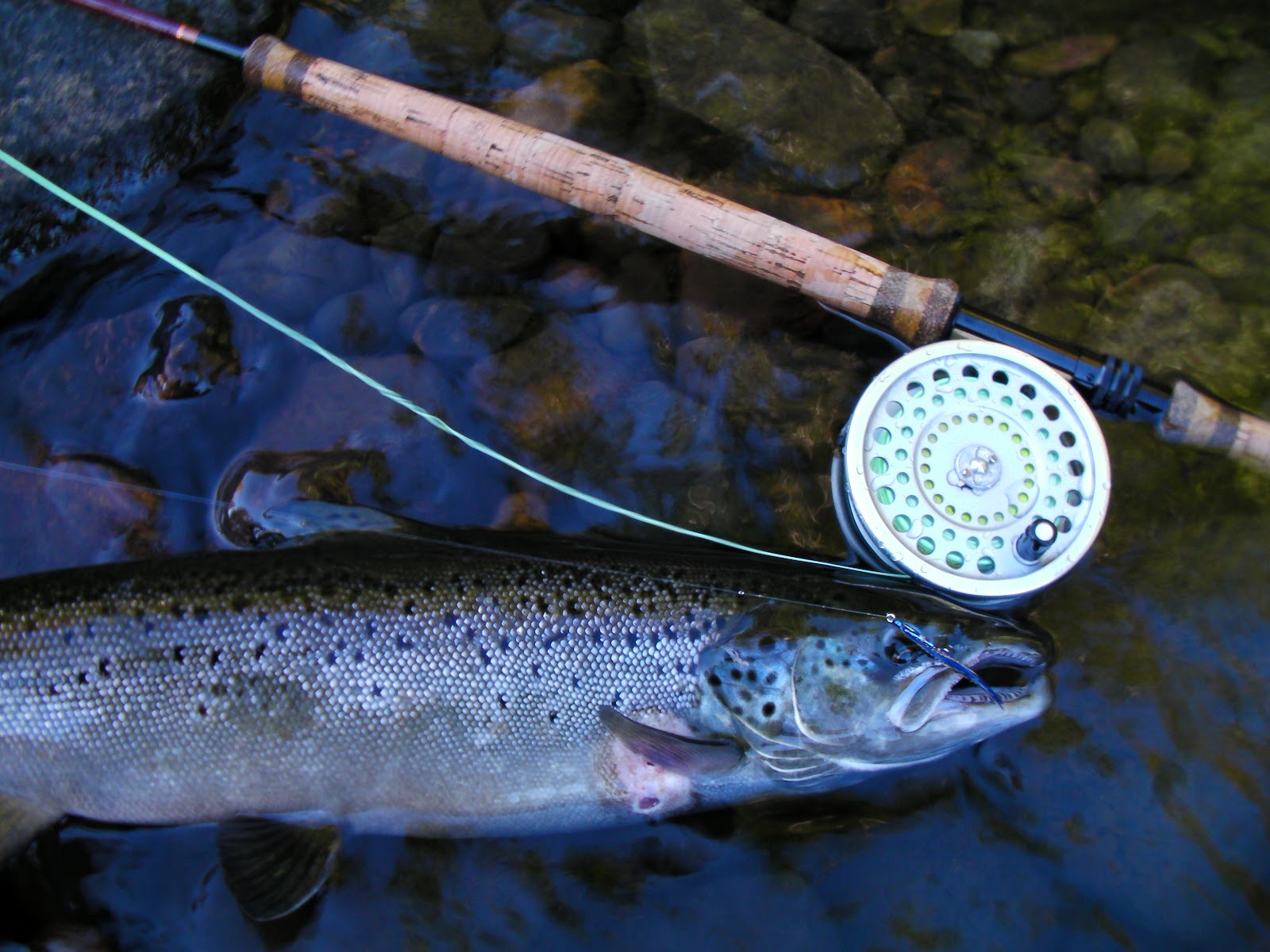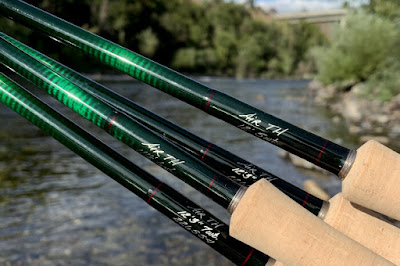Spring Atlantic Salmon Fishing: Chapter 2 Tackle
This spring salmon was hooked in unseasonably low but cold water using an intermediate tip line and medium sized fly
The idea of "success", when it comes to fishing, is different for everyone, but for argument's sake, let's say that here, success is defined by hooking a spring salmon or Springer!
Adaptability is a recurring theme in my blogs. Adapting to conditions that present themselves when your knee deep in a salmon river will bring success more times than not. We'll look at some scenarios where adapting to conditions should be considered.
Tackle:
Rods
Springers are, for the most part, the largest of the run. They use their size and strength to migrate during the highest river levels of a season. Our tackle should reflect that. The 7 or 8 weight rods that we use in summer should be beefed up to 9 to 11 weights. 20 to 30 pound fish are hard enough to land as is.
A 7 weight in fast and high water will leave you undergunned.
The heavier rods are more effective at casting further distances. Covering water is key to finding fish so that extra distance the big rods can provide can make a difference.
Two-handed rods are an excellent tool for spring fishing. The leverage they provide makes lifting sinking lines and heavy flies a breeze compared to single-hand rods. Casting heavy single-handed rods and heavy lines can tire your arms out. What's more, that extra leverage a two-hander delivers, helps in fighting a fish of a lifetime.
Reels
The same idea goes for reels. Big. With a large capacity to fit lots of backing and line. It's important to have a well-balanced outfit, however.
If the rod and reel are properly balanced, you’ll be able to hold the rod with one finger at the balance point and the rod will stay level, not tipping in either direction. The balance point should be where you would usually hold a rod while casting and fishing. A well-balanced outfit will aid in casting distance, accuracy, and will not tire your arms, keeping them rested and ready for a Springer fight!
A good quality reel is important. There is no specific drag system that I prefer over another. So long as the reel will be able to handle the blistering runs of a big Springer! Reels with plastic gears should be avoided. I've seen one reel's plastic gears overheat and break into pieces!!! It was awesome to see!! Not so much for the poor angler holding it!
Big rods and big reels for big fish!
Lines
Spring conditions are unpredictable. Water temperatures, levels, clarity, depth and speed should all be considered when choosing a line system. I prefer having a variety of lines, heads and tips to match the conditions presented. I will change lines accordingly from pool to pool and sometimes in the same pool where depths and current speeds vary from head to tail.
Water temperatures around 10 Celsius (50 Fahrenheit) will determine whether I'll choose a line that fishes on or near the surface or whether I'd fish a sinking line.
Fish are cold-blooded so the colder water will keep them less active or less inclined to chase or rise to a fly near the surface.
When choosing a sinking line, I'll also consider the speed, depth, and clarity of the section of water I will be fishing. I'll choose a line with the proper sinking density to get my fly at a depth between 1 and 3 feet above bottom. Salmon are looking up, so providing water clarity is favourable, the right fish will take a fly anywhere in the water column even when water temperatures are cold, but I prefer this depth when the water tempetature is cold to increase my odds should some fish not want to move far for a fly or especially in low clarity water after a rain event.
A change to a lighter sinktip was required to fish this slower moving tailout compared to the faster running top section of this pool.
There are so many variables that can affect the depth a fly can and will swim at. Fly design, leader length, current speed, a line's sink density, casting angle, line mending, swing speed, etc... There are many ways to achieve depth, keeping these in mind will help you put a fly where you want it.
If fishing sinking lines is new to you, considering all these variables before choosing the right line can be overwhelming and confusing. And not everyone wants to carry 8 different types of lines on them.
Today, fly line companies sell a variety of different lines making it even more confusing.
To make it a little simpler, I'd suggest lining your reel with a running line and buying 3 shooting heads. One floating, one intermediate tip, and one fast sinking tip.
The heads can be changed quickly and if you ever need to get down quicker, you can add on sinking leaders that come in different lengths and sink rates.
But how can you know precisely where your fly is swimming in the water column?
Again, many factors will influence depth. Unfortunately, the only way to truly understand the nuances of keeping your line and fly at a preferred depth is through trial and error. There are a few tricks you can try to lessen the learning curve.
A change in casting angle can help your fly sink
Let's say you are presenting the fly in a traditional down and across manner, casting at a 45 degree, downstream angle and using a sinking line with a 4-foot leader and large fly...
Start with the heaviest head or tip you've got. Note the point in the swing where you feel any sort of hesitation. This is probably where you are hitting the bottom. If you hit it early in the swing or soon after the cast and your getting hung up in the rocks, then your head or tip is too heavy.
If too heavy, switch to a lighter tip and continue switching until you don't feel bottom throughout the entire swing.
If too light, you can switch to a heavier tip or change your casting angle closer to a 90 degree angle and mend upstream to create a dead drift in your rig and fly. This will give your tip and fly time to sink at a depth the line's sink rate will allow. For example, a Type 3 sink tip will sink 3 Inches per second. So casting your line closer to a 90-degree angle, mending upstream, and letting it dead drift for 4 seconds, will get your line down 1-foot before your line starts its swing. The longer it dead drifts, the deeper it will sink.
If you don't feel any bumps or don't snag the bottom by the end of your swing and when the line is on the dangle, count the seconds before it hits bottom. This will give you an approximation of how close to bottom your rig is.
Dependent on the current speed, the speed of the swing will also influence depth. A slow swing will give your rig more time to get down.
A fast swing speed will make the rig rise toward the surface.
A moderate speed(fast walking pace)swing will keep at the same level throughout the swing.
It's good to know when and how to use different swing speeds to your advantage, adapting to the conditions at hand.
This springer was hooked in a deep lie after I switched from an intermediate tip to a type 5 sinktip.
Leaders
Just like the rods and reels, heavier is best. Landing a fish of a lifetime is serious business. Your weakest link should hold up to a possible 40-pound salmon.
Springers are not leader shy. Use what you like. I prefer a minimum of 20-pound test.
Double-check the strength of your knots!!
All this heavy tackle is necessary to deliver sinktips and to fight and land big fish, but the most important function is delivering flies!! My favorite topic!!
In Chapter 3, we'll look at how I decide which flies I prefer to tempt a fresh spring salmon!
This tube fly design accounted for 2 springers










Comments
Post a Comment